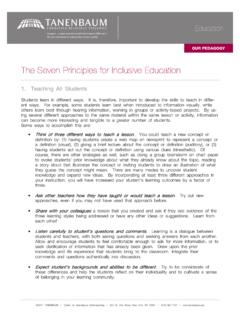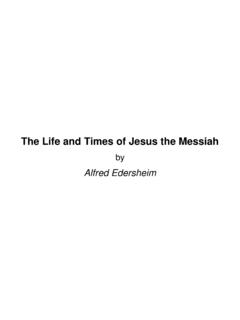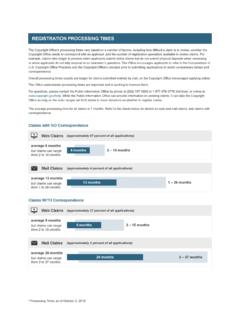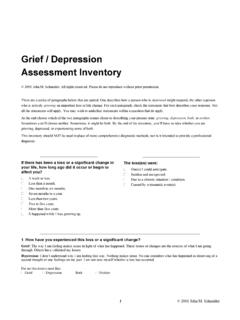Transcription of Contains nine ready-made lesson plans for grades 6-12 ...
1 TEACHER'S GUIDE Contains nine ready - made lesson plans for grades 6-12 Supports meaningful learning and critical literacy 1. Meets content standards in history, civics, visual arts, music and language arts TEACHER'S GUIDE. grades 6-12. Contents INTRODUCTION 3. ACTIVITY 1. Viewing the Film 5. ACTIVITY 2. Refuse to Stand Silently By 7. ACTIVITY 3. The Birmingham Pledge 11. ACTIVITY 4. Music and the Movement 13. ACTIVITY 5. Primary Documents 15. ACTIVITY 6. Strong Women and Gentle Men 21. ACTIVITY 7. Contemporary Movements 23. ACTIVITY 8. Mix It Up 25. CURRICULUM STANDARDS. ACTIVITY 9 Mighty Times: The Children's March ad- Sustainability 27 dresses a range of curriculum standards. A comprehensive list of standards aligned RESOURCES 29 with the film and classroom activities are CREDITS 30 included as a PDF on the CD with the kit.
2 Sooner or later being less human leads the oppressed to struggle against those who made them so. In order for this struggle to have meaning, the oppressed must not, in seeking to regain their humanity (which is a way to create it), become in turn oppressors of the oppressed, but rather restorers of the humanity of both. Paulo Freire, educator 2. Introduction In 1963, Birmingham was Alabama's biggest city;. many considered it the baddest as well. From 1957 to 1963, there had been 18 bombings in Birmingham but no arrests. In 1957, the Rev. Fred Shuttlesworth was chain-whipped by a crowd because he attempted to enroll his children into an all-white school. His wife was stabbed. Again, there were no arrests.
3 In 1961, a black man was dragged from the streets to a shack and then castrated. There were no arrests. Freedom riders were almost beaten to death in 1961 when they entered Birmingham. But there were no arrests. The black children of Birmingham felt oppressed at every turn, and in the spring of 1963 they played a vital role in restoring humanity to themselves and to a race-divided America. William Glasser, author and educator, believes that students are driven by six basic needs: survival, power, love, belonging, freedom and fun. The word power has many negative connotations in our culture. Maria Harris, author of Teaching and Re- ligious Imagination, re-envisions a negative concept of power and instead writes about the grace of power.
4 The grace of power is present when we discover our own power and then exercise it. When we discover our power, we move toward a second kind of power, the power to rebel. Rebellion is the expression of feeling that comes when we name those injustices and sufferings that are not to be toler- ated. Engaging in rebellion means claiming the right to say that injustice is wrong. In naming injustice, we keep alive the human feeling of protest. When we name injustice, we are led to a third power, the power to resist. Resistance is active opposi- tion toward injustice. Resistance is refusal to accept the way things are because things can be different. The power to rebel and the power to resist must always be present with the power to love.
5 If the end is not love, we revert back to a negative construct of power; we revert back to being oppressors. The film and teacher's guide are about power. The 3. grace of power. The power to rebel. The power to re- sist. And the power to love. If we are to reach real peace On May 2, 1963, in Birmingham, Ala., about 1,000 in this world, and if we are to students went to jail. By May 10th, 3,000 were in jail. What spurred thousands of children to action? carry on a real war against What gave them the power to rebel and resist? How is it that children of all ages were the ones to garner the war, we shall have to begin largest victory seen thus far in the civil rights move- with the children.. ment? How did the power of love form their strate- Mahatma Gandhi, peacemaker gies and their actions?
6 And how can educators today invite students to experience anew the legacy of the children of Birmingham? MATERIALS. The kit for Mighty Times: The Children's March includes a 40-minute film, an accompanying teacher's guide and an evaluation form. Once you have used this curriculum in your classroom, please complete and return the evaluation form. Your feedback will aid us in making improvements to future editions. I consider that attitude of rebellion as one of the most promising aspects of our political life not because I. espoused it as a form of action, but because it represented a symptom of advancement, and introduction to a more complete humanity.. Paulo Freire, educator 4. ACTIVITY 1. Viewing the Film OBJECTIVES.
7 Students will understand political movements in- volve children as well as adults. Students will understand children of all ages have the power to make a difference in the world. TIME AND MATERIALS. Two class sessions (one to watch the film and one to discuss the film). Copy of The Children's March film Film guide handouts for each student (Make your own based on the questions below or download the PDF of examples included on the CD with the kit.). FRAMEWORK. The following questions are in the same order as the film. Students can fill them out as they watch the film or use them as a discussion guide following the film. Or students can complete them individually as a homework assign- ment, or in small groups after viewing the film.
8 Pull out selected questions for general whole-group discussion. Make as many connections as possible to students' local communities and lives. These questions are given as a guide. (Answers are included as a PDF on the CD with the kit.). 1. What was Birmingham's nickname and why? 6. Dr. King said in a strategy session that the only way we're going to break Birmingham is to fill the 2. Have you ever seen a white tank anywhere before? jails. What do you think a strategy session is? Why is What might a white tank symbolize to white people? it important? What might it symbolize to black people? 7. Why do you think that Dr. King said no, at first, to 3. The film states, Under Bull Connor, Birmingham kids going to jail?
9 Was the closest thing in America to a police state.. What is a police state? 8. Shelley The Playboy told the kids that there's going to be a party in the park today. What did he mean? 4. Why couldn't the parents or adults protest? What would happen to them if they did protest? 9. What did the children's teacher, Mrs. Goree, do to help them go to the march? 5. What does it mean to meet violence with nonvio- lence ? What would it look like? 5. ACTIVITY 1. 16. There were 10 kids still standing after everyone else had been knocked down or dispersed by the fire hoses. What were they singing? 17. What did President Kennedy think of the photo- graphs he saw of children being hosed on the second day of the march?
10 18. What were the conditions in the jails? Were they clean? What did the children get to eat? How long were they kept in jail? 19. What did the kids do in jail? 20. How old was the youngest child who got arrested and put in jail? 21. Dr. King told the parents, Don't worry about your children. They are going to be all right. Don't hold them back if they want to go to jail for they are doing a job for all of America and for all mankind. What job were they doing? 10. Kelly Ingram Park was the big green buffer be- tween black Birmingham and the white downtown. 22. The white detective said that in the end there Do buffers exist between groups in your community? was no way to hold a lid on this because the fear was gone.















